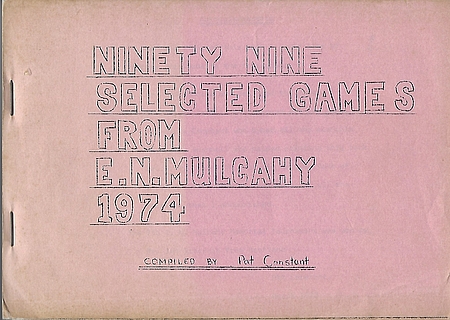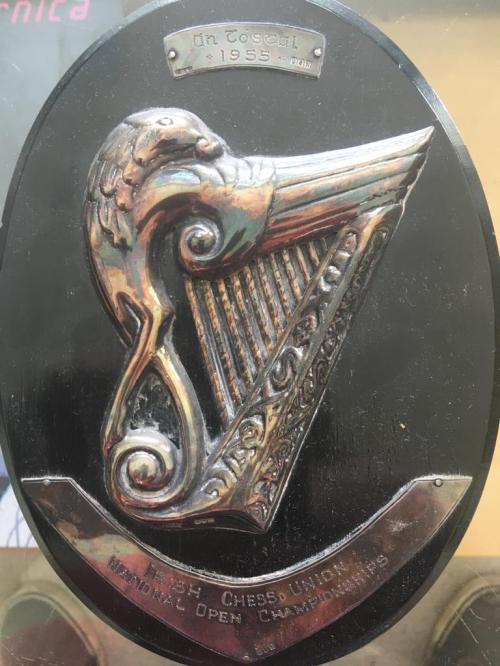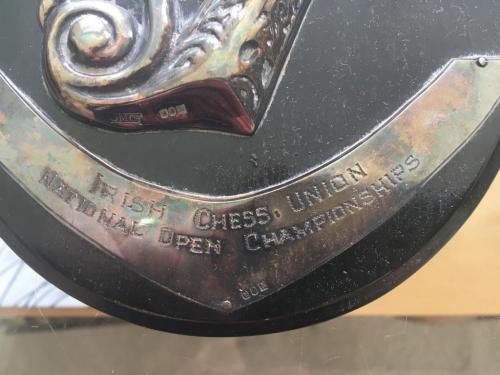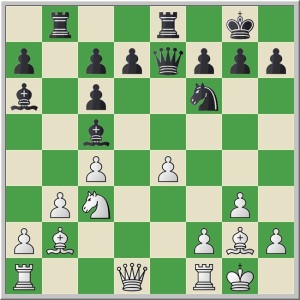As promised on the front cover above, the tournament bulletin of the 1974 Mulcahy Memorial contains inter alia the game-scores of 99 encounters from the tournament – approximately three-quarters of the games actually played.
However, only 98 of those games have found their way into the digital databases. So what happened to Game 99 or, using the numbering in the tournament book, Game 24?
The answer appears to be that whoever put together the original digital database was flummoxed by a typographical error in the bulletin, and left the game out.
So here is my reconstruction of the game with a suggested correction for that typo.
Laurence Roche (White) -v- Seán Galligan (Black)
Mulcahy Memorial, Cork, December 1974 (Round 2)
[Play through the game in Chessbase Reader]
1.e4 e6 2.d4 d5 3.Nd2 c5 4.exd5 exd5 5.Ngf3 Nf6 6.dxc5 Bxc5 7.Nb3 Bd6 8.Bb5+ Bd7 9.Bxd7+ Nbxd7 10.0-0 0-0 11.Bg5 Rc8 12.c3
In the tournament book, the next moves are given as 12…P-QR3 13. B-R4 P-QN4 14. B-N3 B-B1 15. N-B5 N-B4 16. N/3-Q4.
The difficulty with this sequence is that on Black’s 14th move, the Bishop cannot go back to its original square because there is a Rook there; also White’s 15th move would require two hops of either Knight.
So we need to insert a Black Rook move and a White Knight move to make the game-score work. There is more than one way to achieve this, but I have chosen the most likely move order.
12…Re8 13.Nbd4 a6 14.Bh4 b5 15.Bg3 Bf8 16.Nf5 Nc5 17.N3d4 g6 18.Ne3 Bg7 19.Qc2 Nfe4 20.Rad1 Nxg3 21.hxg3 Ne4 22.Ne2 b4 23.Rxd5 Qb6 24.c4 Nxf2 25.Rxf2 Rxe3 26.Kf1 Rce8 27.Rd7 Qe6 28.Rfxf7
28…Qxf7+ 29.Rxf7 Kxf7 30.Nf4 Re1+ 31.Kf2 Bd4+ 32.Kf3 Rf1+ 33.Kg4 h5+ 34.Kg5 Bf6+ 0-1
The tournament was won by the Scottish player Ian Sinclair.
Final Crosstable
No Name Total 1 2 3 4 5 6 1 Sinclair, I 5.5 28:W 43:W 12:W 7:W 8:W 2:D 2 Kernan, B 5 18:W 38:D 31:W 14:W 7:W 1:D 3 O'Sullivan, E 4.5 44:W 14:D 9:W 5:D 16:W 4:D 4 Healy, D 4.5 29:W 25:W 23:D 6:D 15:W 3:D 5 O'Brien, J 4 6:D 20:W 17:W 3:D 12:D 10:D 6 Wallace, P 4 5:D 11:W 16:D 4:D 33:W 8:D 7 Galligan, S 4 46:W 24:W 22:W 1:L 2:L 12:W 8 Noone, J 4 42:W 17:D 13:W 23:W 1:L 6:D 9 Healy, H 4 0:W 13:D 3:L 18:D 25:W 23:W 10 Kennefick, M 4 27:W 12:L 11:D 26:W 30:W 5:D 11 Brennan, J 4 32:D 6:L 10:D 36:W 35:W 13:W 12 Devenney, R 3.5 34:W 10:W 1:L 29:W 5:D 7:L 13 Muldoon, P 3.5 37:W 9:D 8:L 38:W 22:W 11:L 14 Kennedy, J 3.5 35:W 3:D 38:W 2:L 19:L 31:W 15 Penny, L 3.5 26:L 40:W 21:W 37:+ 4:L 22:D 16 Short, J 3.5 43:D 32:W 6:D 25:W 3:L 18:D 17 Dillon, P 3.5 33:W 8:D 5:L 24:L 39:W 30:W 18 Nolan, R 3.5 2:L 30:D 39:W 9:D 34:W 16:D 19 O'Briain, M 3.5 40:W 22:L 33:D 20:W 14:W 24:- 20 Short, P 3.5 41:D 5:L 42:W 19:L 38:W 28:W 21 Casey, G 3.5 22:L 45:W 15:L 42:D 32:W 29:W 22 Matthews, M 3 21:W 19:W 7:L 28:D 13:L 15:D 23 Moroney, J 3 39:W 26:W 4:D 8:L 24:D 9:L 24 Roche, L 3 30:W 7:L 28:D 17:W 23:D 19:- 25 O'Connor, E 3 36:W 4:L 41:W 16:L 9:L 38:W 26 McCarthy, A 3 15:W 23:L 29:L 10:L 44:W 34:W 27 Cahill, J 3 10:L 28:L 46:W 34:L 40:W 35:W 28 Blair, D 2.5 1:L 27:W 24:D 22:D 29:D 20:L 29 McCarthy, P 2.5 4:L 36:W 26:W 12:L 28:D 21:L 30 Sheehan, J 2.5 24:L 18:D 43:W 31:W 10:L 17:L 31 Fitzgibbon, W 2.5 47:+ 41:D 2:L 30:L 42:W 14:L 32 Lynch, P 2.5 11:D 16:L 44:W 33:L 21:L 39:W 33 Gibson, J 2.5 17:L 34:W 19:D 32:W 6:L 0: 34 Collins, T 2 12:L 33:L 40:W 27:W 18:L 26:L 35 Flynn, R 2 14:L 44:W 37:L 41:W 11:L 27:L 36 Moroney, S 2 25:L 29:L 45:W 11:L 41:W 0: 37 Alfred, J 2 13:L 46:W 35:W 15:- 0: 0: 38 Coveney, M 1.5 45:W 2:D 14:L 13:L 20:L 25:L 39 Hinds, D 1.5 23:L 42:D 18:L 43:W 17:L 32:L 40 Clarke, S 1.5 19:L 15:L 34:L 46:W 27:L 41:D 41 Myers, T 1.5 20:D 31:D 25:L 35:L 36:L 40:D 42 Scanlon, J 1 8:L 39:D 20:L 21:D 31:L 45:- 43 Byrne, P 1 16:D 1:L 30:L 39:L 46:D 0: 44 O'Shea, M 1 3:L 35:L 32:L 45:W 26:L 46:- 45 O'Sullivan, T 1 38:L 21:L 36:L 44:L 0:W 42:- 46 Shorten, T .5 7:L 37:L 27:L 40:L 43:D 44:- 47 Ireton, T 0 31:- 0: 0: 0: 0: 0:
















